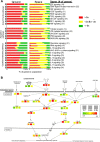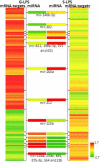An integrated omics analysis: impact of microgravity on host response to lipopolysaccharide in vitro
- PMID: 25102863
- PMCID: PMC4287545
- DOI: 10.1186/1471-2164-15-659
An integrated omics analysis: impact of microgravity on host response to lipopolysaccharide in vitro
Abstract
Background: Microgravity facilitates the opportunistic infections by augmenting the pathogenic virulence and suppressing the host resistance. Hence the extraterrestrial infections may activate potentially novel bionetworks different from the terrestrial equivalent, which could only be probed by investigating the host-pathogen relationship with a minimum of terrestrial bias.
Results: We customized a cell culture module to expose human endothelial cells to lipopolysaccharide (LPS). The assay was carried out onboard the STS-135 spaceflight, and a concurrent ground study constituted the baseline. Transcriptomic investigation revealed a possible immune blunting in microgravity suppressing in particular Lbp, MyD88 and MD-2, which encode proteins responsible for early LPS uptake. Certain cytokines, such as IL-6 and IL-8, surged in response to LPS insult in microgravity, as suggested by the proteomics study. Contrasting proteomic expressions of B2M, TIMP-1 and VEGRs suggested impaired pro-survival adaptation and healing mechanisms. Differential expression of miR-200a and miR-146b suggested the susceptibility of hosts in spaceflight to oxidative stress and further underscored the influence of microgravity on the immunity.
Conclusions: A molecular interpretation explaining the etiology of the microgravitational impact on the host-pathogen relationship elucidated comprehensive immune blunting of the host cells responding to LPS challenges. Longer LPS exposure prompted a delayed host response, potentially ineffectual in preventing pathogens from opportunistic invasion. Significant consequences include the subsequent failure in recruiting the growth factors and a debilitated apoptosis. Follow up studies with larger sample size are warranted.
Figures





References
Publication types
MeSH terms
Substances
LinkOut - more resources
Full Text Sources
Other Literature Sources
Molecular Biology Databases
Research Materials
Miscellaneous

